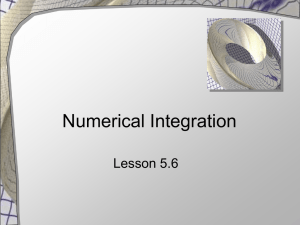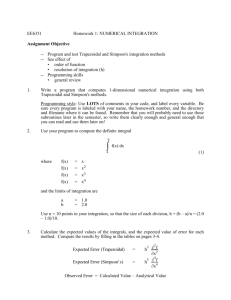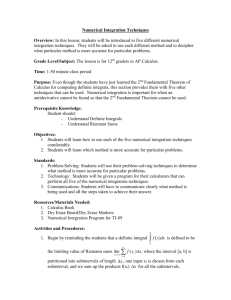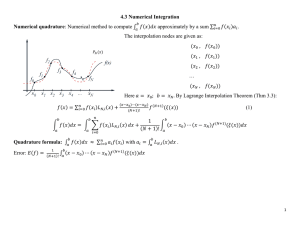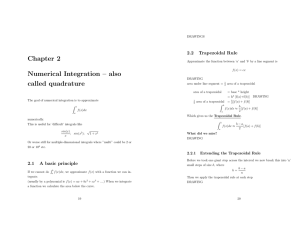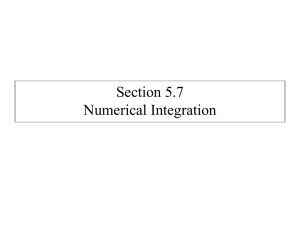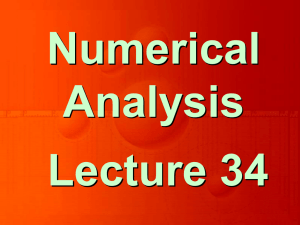Chapter 21 Odd Problem Solutions
advertisement
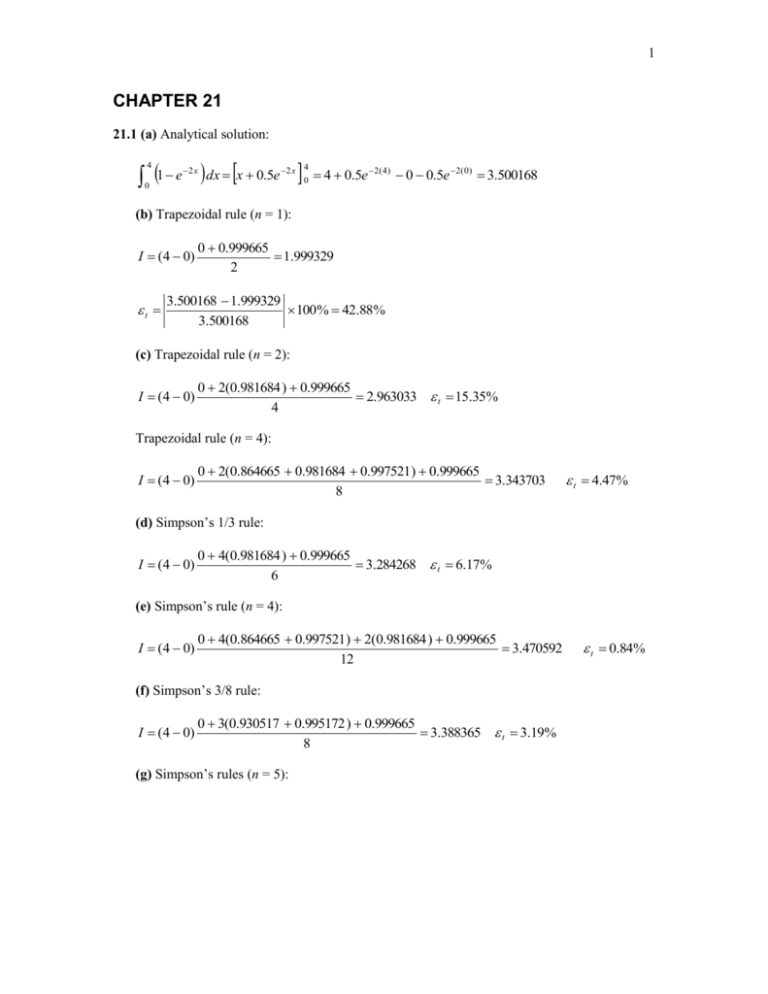
1 CHAPTER 21 21.1 (a) Analytical solution: 1 e dx x 0.5e 4 2 x 0 2 x 4 0 4 0.5e 2( 4) 0 0.5e 2(0) 3.500168 (b) Trapezoidal rule (n = 1): I (4 0) t 0 0.999665 1.999329 2 3.500168 1.999329 100% 42.88% 3.500168 (c) Trapezoidal rule (n = 2): I (4 0) 0 2(0.981684 ) 0.999665 2.963033 t 15.35% 4 Trapezoidal rule (n = 4): I (4 0) 0 2(0.864665 0.981684 0.997521) 0.999665 3.343703 8 t 4.47% (d) Simpson’s 1/3 rule: I (4 0) 0 4(0.981684 ) 0.999665 3.284268 t 6.17% 6 (e) Simpson’s rule (n = 4): I (4 0) 0 4(0.864665 0.997521) 2(0.981684 ) 0.999665 3.470592 12 (f) Simpson’s 3/8 rule: I (4 0) 0 3(0.930517 0.995172 ) 0.999665 3.388365 t 3.19% 8 (g) Simpson’s rules (n = 5): t 0.84% 2 I (1.6 0) 0 4(0.798103 ) 0.959238 6 (4 1.6) 0.959238 3(0.99177 0.998338 ) 0.999665 8 1.107107 2.378769 3.485876 t 0.41% 21.3 (a) Analytical solution: 4 4 2 x2 x6 (1 x 4 x 2 x ) dx x x 4 1104 2 3 2 3 5 (b) Trapezoidal rule (n = 1): I (4 (2)) 29 1789 5280 2 t 1104 5280 100% 378 .26% 1104 (c) Trapezoidal rule (n = 2): I (4 (2)) 29 2(2) 1789 2634 t 138.59% 4 Trapezoidal rule (n = 4): I (4 (2)) 29 2(1.9375 2 131.3125 ) 1789 1516 .875 8 t 37.398% (d) Simpson’s 1/3 rule (n = 2): I (4 (2)) 29 4(2) 1789 1752 t 58.7% 6 (e) Simpson’s 3/8 rule: I (4 (2)) 29 3(1 31) 1789 1392 t 26.087% 8 (f) Boole’s rule (n = 5): I (4 (2)) 7(29) 32(1.9375 ) 12(2) 32(131.3125 ) 7(1789 ) 1104 90 21.5 Analytical solution: t 0% 3 5 3 5 1 (4 x 3) dx (4 x 3) 4 2056 16 3 3 Simpson’s rule (n = 4): I (5 (3)) 3375 4(343 729) 2(1) 4913 2056 12 t 0% Simpson’s rules (n = 5): I (0.2 (3)) (5 0.2) 3375 4(636 .056 ) 10.648 6 10.648 3(74.088 1191 .016 ) 4913 3162 .6 5218 .598 2056 8 t 0% Because Simpson’s rules are perfect for cubics, both versions yield the exact result for this cubic polynomial. 21.7 Analytical solution: 1.5 0.5 1.5 14 2x 1 dx 14 2 x 517 .2301 2 ln 14 0.5 (a) Trapezoidal rule (n = 1): I (1.5 0.5) 14 2744 1379 2 t 517.2301 1379 100% 166.612% 517.2301 (b) Simpson’s 1/3 rule (n = 2): I (1.5 0.5) 14 4(196) 2744 590.3333 t 14.134% 6 (c) Simpson’s 3/8 rule: I (1.5 0.5) 14 3(81.323 472.3879 ) 2744 552.3916 t 6.798% 8 (d) Boole’s rule: I (1.5 0.5) 7(14) 32(52.3832 ) 12(196) 32(733.3648 ) 7(2744 ) 520.0215 t 0.5397 % 90 (e) Midpoint method: I (1.5 0.5)196 196 t 62.106 % 4 (f) 3-segment-2-point open integration formula: I (1.5 0.5) 81.323 472.3879 276.8554 2 t 46.473% (g) 4-segment-3-point open integration formula: I (1.5 0.5) 2(52.3832 ) 196 2(733.3648 ) 458.4987 3 t 11.355% 21.9 Analytical solution: t z (t ) t 0 m gcd gcd gm tanh t dt ln cosh t m cd c m 0 d 10 68.1 9.8(0.25) z (10) ln cosh (10) 333 .9262 68.1 0.25 0 Thus, the result to 3 significant digits is 334. Here are results for various multiple-segment trapezoidal rules: n 1 2 3 4 5 6 7 8 9 10 11 12 13 14 I 246.9593 314.4026 325.4835 329.216 330.9225 331.8443 332.3984 332.7573 333.0031 333.1788 333.3087 333.4074 333.4842 333.5452 Thus, a 14-segment application gives the result to 4 significant digits. 21.11 (a) Trapezoidal rule (n = 6): I (10 (2)) 35 2(5 10 2 5 3) 20 65 12 5 (b) Simpson’s rules (n = 6): I (10 (2)) 35 4(5 2 3) 2(10 5) 20 56.66667 18 21.13 (a) Analytical solution: 0.6 2e 1.5 x dx 1.33333 e 1.5 x 0 0.6 0 0.54209 (1.33333 ) 0.79124 (b) Trapezoidal rule I (0.05 0) 2 1.8555 1.8555 1.597 1.597 1.3746 (0.15 0.05) (0.25 0.15) 2 2 2 (0.35 0.25) 1.3746 1.1831 1.1831 0.9808 (0.475 0.35) 2 2 (0.6 0.475) t 0.9808 0.8131 0.79284 2 0.79124 0.79284 100% 0.2022 % 0.79124 (c) Trapezoidal/Simpson’s rules I (0.05 0) 1.8555 3(1.597 1.3746 ) 1.1831 2 1.8555 (0.35 0.05) 2 8 (0.6 0.35) t 1.1831 4(0.9808 ) 0.8131 0.791282 6 0.79124 0.791282 100% 0.0052 % 0.79124 21.15 (a) Analytical solution: 2 2 1 2 0 3 2 ( x 3 yz) dx dy dz 2 3 2 0 20 12 yz dy dz 40 z 12 z 2 2 2 2 2 3 yzx dy dz 0 4 3 20 y 6 y z 2 2 160 (b) For z = –2, sweeping across the x dimension: z = –2; y = 0: 1 2 x 4 2 2 0 dz 2 2 40 24 z dz 6 27 4(1) 1 20 6 I (1 (3)) z = –2; y = 1: 21 4(5) 7 4 6 I (1 (3)) z = –2; y = 2: I (1 (3)) 15 4(11) 13 28 6 These values can then be integrated along the y dimension: I (2 0) 20 4(4) 28 8 6 For z = 0, similar calculations yield z = 0; y = 0: I = –20 z = 0; y = 1: I = –20 z = 0; y = 2: I = –20 These values can then be integrated along the y dimension: I (2 0) 20 4(20) 20 40 6 For z = 2, similar calculations yield z = 2; y = 0: I = –20 z = 2; y = 1: I = –44 z = 2; y = 2: I = –68 These values can then be integrated along the y dimension: I (2 0) 20 4(44) 68 88 6 Finally, these results can be integrated along the z dimension, I (2 (2)) 8 4(40) 88 160 6 t 0% 21.17 Here is a VBA program that is set up to duplicate the computation performed in Example 21.5. Option Explicit Sub Dim Dim Dim TestSimpm() n As Integer, i As Integer a As Double, b As Double, h As Double x(100) As Double, f(100) As Double 7 'Enter data and integration parameters a = 0 b = 0.8 n = 4 h = (b - a) / n 'generate data from function x(0) = a f(0) = fx(a) For i = 1 To n x(i) = x(i - 1) + h f(i) = fx(x(i)) Next i 'invoke function to determine and display integral MsgBox "The integral is " & Simp13m(h, n, f) End Sub Function Simp13m(h, n, f) Dim i As Integer Dim sum As Double sum = f(0) For i = 1 To n - 2 Step 2 sum = sum + 4 * f(i) + 2 * f(i + 1) Next i sum = sum + 4 * f(n - 1) + f(n) Simp13m = h * sum / 3 End Function Function fx(x) fx = 0.2 + 25 * x - 200 * x ^ 2 + 675 * x ^ 3 - 900 * x ^ 4 + 400 * x ^ 5 End Function 21.19 (a) Analytical solution: M 11 0 5 0.25 x 2 dx 5x 0.083333 x 3 11 0 165.9167 (b) Trapezoidal rule: I (1 0) 5 5.25 5.25 6 (2 1) 166.375 2 2 (c) Simpson’s rule: I (2 0) 5 4(5.25) 6 6 4(7.25) 9 (4 2) 165.9167 6 6 21.21 (a) Trapezoidal rule I (2 1) 56 6 5.5 m min 60 s (3.25 2) 60.375 3,622.5 m 2 2 s min (b) Trapezoidal/Simpsons rules 8 I (2 1) 6 4(5.5) 7 56 7 8.5 (4.5 2) (6 4.5) 2 6 2 (9 6) 8.5 3(8 6) 7 7 4(7) 5 m min 60 s (10 9) 59.9375 3,596 .25 m 8 6 s min (c) We can use regression to fit a quadratic equation to the data y = -0.1117x2 + 1.3526x + 3.4447 10 R2 = 0.5742 5 0 0 2 4 6 8 10 12 This equation can be integrated to yield M 10 0.1117 x 2 + 1.3526 x + 3.4447 dx 0.03723 x 3 + 0.6763 x 2 + 3.4447 x 1 60.7599 10 1 m min 60 s 3,645 .594 m s min We can use regression to fit a cubic equation to the data y = -0.01646x3 + 0.16253x2 + 0.07881x + 4.85467 10 R2 = 0.63442 5 0 0 2 4 6 8 10 12 This equation can be integrated to yield M 10 1 0.01646 x 3 + 0.16253 x 2 + 0.07881x 4.85467 dx 0.00412 x 4 + 0.054177 x 3 + 0.039405 x 2 + 4.85467 x 60.56973 10 1 m min 60 s 3,634 .184 m s min 21.23 We can set up a table that contains the values comprising the integrand t, hr t, d rate (cars/4 min) rate (cars/d) 9 7:30 7:45 8:00 8:15 8:45 9:15 0.312500 0.322917 0.333333 0.343750 0.364583 0.385417 18 24 14 24 21 9 6480 8640 5040 8640 7560 3240 We can integrate this data using a combination of Simpson’s 3/8 and 1/3 rules. This yields the number of cars that go through the intersection between 7:30 and 9:15, I (0.34375 0.3125 ) 6480 3(8640 5040 ) 8640 8 (0.385417 0.34375 ) 8640 4(7560 ) 3240 6 219.375 292.5 511.875 cars The number of cars going through the intersection per minute can be computed as 511.875 cars hr cars 4.875 1.75 hr 60 min min
